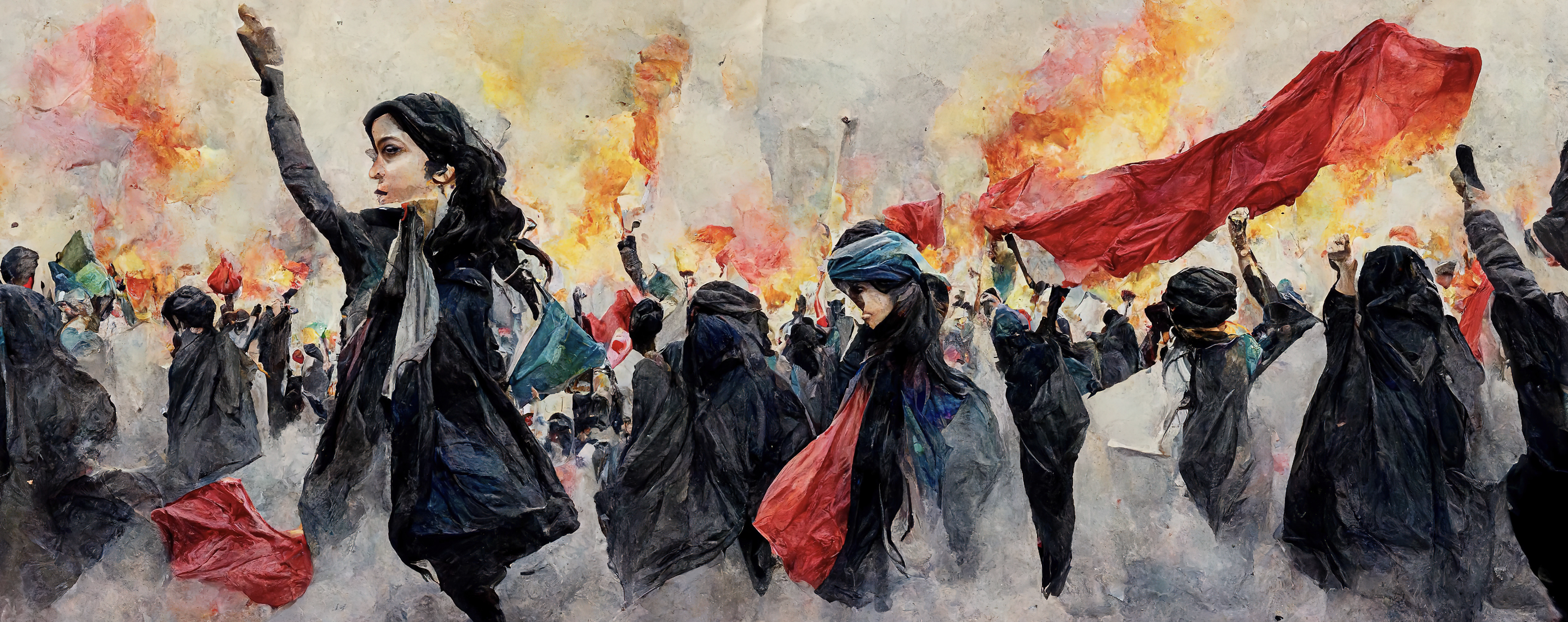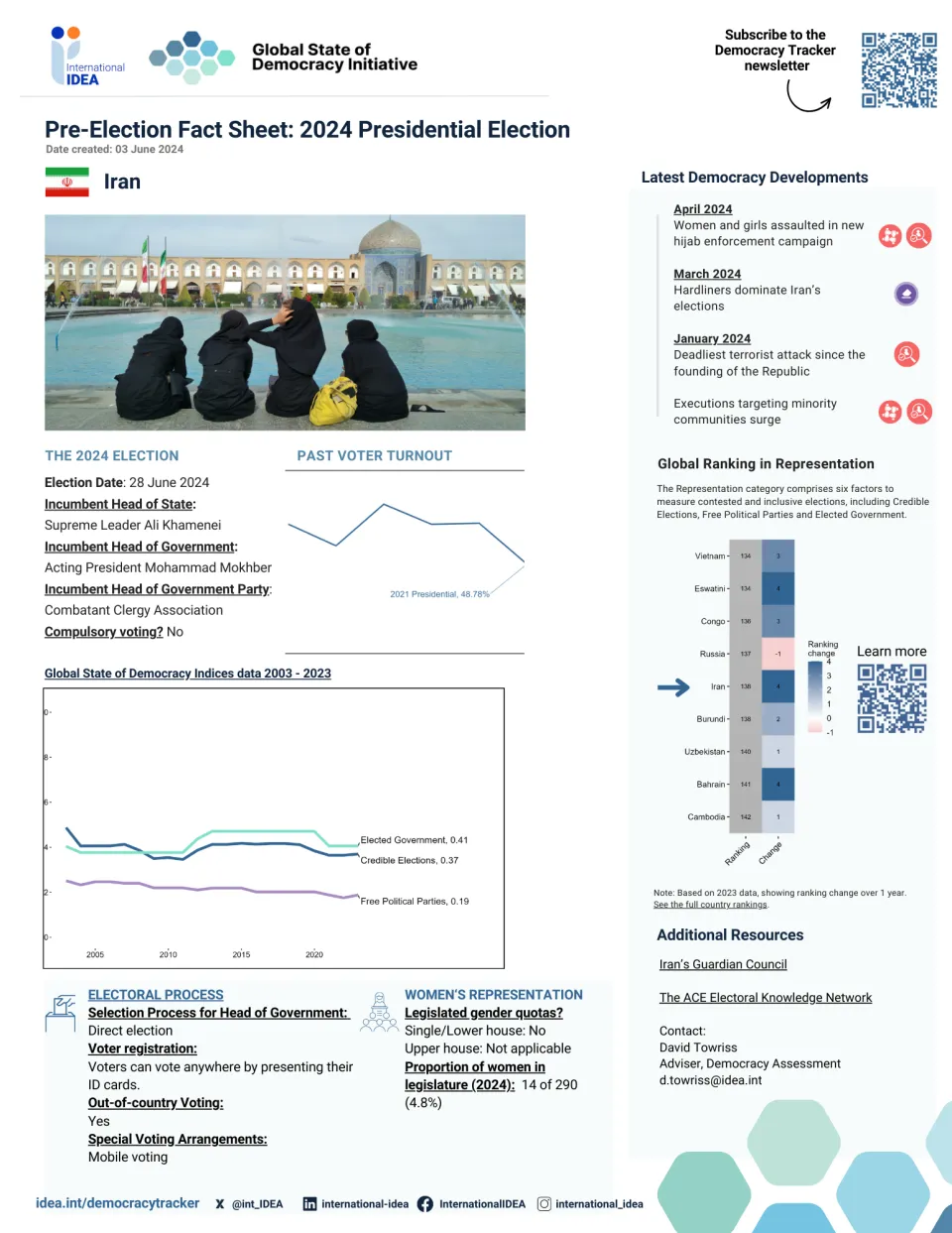
Iran
The Islamic Republic of Iran performs in the low range across all four categories of the Global State of Democracy framework. The country is an Islamic theocracy led by clerics who wield significant power. Over the last five years, Iran has experienced notable declines in multiple factors of Representation and Rights. Economically, Iran is an upper-middle income country and a major oil and natural gas-producing state with sizable hydrocarbon, agriculture, and service sectors. The country’s economy has experienced stagnation, primarily due to several rounds of Western sanctions and volatility in oil prices, which have dampened economic growth. However, the country ranks moderately well in the Human Development Index, underpinned by a young and educated workforce, which reflects its economic potential.
Iran’s political culture is dominated by ardent debates between tradition-oriented, conservative hardliners and modernist reformers. Since a 1979 revolution overthrew the then-reigning monarchy and replaced it with an Islamic Republic, divisions over religion, democracy, freedom, rights, and Iran’s place in the world have festered. Iran’s legal system is based on a strict interpretation of Islamic law, one that represses a broad spectrum of minorities and dissenting voices. Iran punishes LGBTQIA+ people with execution and mandates that all women wear the hijab in public. Repeated human rights violations have inspired recurring protests demanding greater rights and freedoms. Members of minority religious groups, particularly the Baha’i faith, face ongoing persecution and discrimination. Iran’s ethnic minorities, which comprise roughly 40 per cent of the population, also face repression. The urban-rural divide is especially strong in Iran, with large cities tending to support political reformers and movements that seek liberalization while less densely populated regions are more conservative. Major divides manifest, too, in the area of foreign policy and Iran has been largely isolated since the 1979 revolution, especially in relation to the West. Iran’s size and strategic location on the Persian Gulf position the country as a Shia Muslim regional power in strategic rivalry with Sunni Muslim leader Saudi Arabia, historically leveraging the Sunni-Shia divide to advance their interests and fuel sectarian violence across the region in struggles for regional dominance. While many in Iran continue to support the current anti-West and anti-Israel approach, there also exist significant voices in favor of a rapprochement with the West. Corruption, state domination of the economy, and women’s unemployment continue to be key issues that undermine Iran’s economy and fuel popular discontent.
The election of a hardline administration in Iran in 2021 signaled a significant shift from the previous reformist era. Since then, Iran has undertaken a brutal crackdown on protestors, employed inflammatory rhetoric in its public pronouncements, and sought to align itself with other authoritarian powers, most notably Russia and China. Human rights violations, including Internet censorship, torture, and execution, remain rampant in Iran as the government seeks to maintain power amid a legitimacy crisis. In September 2022, large-scale protests broke out over the death of Mahsa Amini in police custody, prompting many women to remove their headscarves in defiance of the government’s restrictions on women’s freedoms, as well as other autocratic norms. The 2024 sudden death of President Ebrahim Raisi is likely to accelerate the shift towards a more hardline leadership, risking a recurrence of low voter turnout.
Looking ahead, Rights and Rule of Law will be critical areas to watch, especially with an eye to how the government handles future protests. The political stability of the country remains uncertain, with Supreme Leader Ali Khamenei’s advanced age and health issues adding to the uncertainty regarding the country’s future leadership. New sanctions on Iran will likely continue to hinder the country’s already troubled economy, potentially leading to further the societal drive to reform the system.
Last Updated: June 2024
https://www.idea.int/democracytracker/
July 2024
Reformist Masoud Pezeshkian wins snap presidential election

On 5 July, presidential candidate Masoud Pezeshkian, representing the reformist political faction, won the second round of the Iranian presidential election with 53.7 percent of the vote. He defeated his hardline opponent, Saeed Jalili. Voter turnout reached 49.8 percent, higher than the record low 39.93 percent registered in the first round. This snap election was called following the sudden death of former President Ebrahim Raisi in a helicopter crash on 19 May. Initially, 80 candidates, including four women, registered for candidacy. However, Iran’s Guardian Council, responsible for overseeing the elections and vetting candidacies, approved only six male candidates. Two candidates withdrew prior to the first round, leaving four contenders in the race. Since no candidate secured the required 50 per cent of the vote in the first round, a runoff was held between the top two candidates, Pezeshkian and Jalili. Pezeshkian's swearing-in ceremony took place on 30 July.
Sources: BBC, Al Jazeera, IRNA, Mehr News Agency, Al Arabiya
April 2024
Women and girls assaulted in new hijab enforcement campaign
Women and girls in Iran have been subjected to a violent crackdown by the country’s police as part of a new hijab enforcement campaign announced by authorities on 13 April. The UN and media outlets reported that women and girls across the country were being harassed and detained, with some alleging that they had been beaten and sexually assaulted. Surveillance cameras were reportedly being used to identify individuals not complying with the mandatory hijab laws and hundreds of businesses were forced to close for not enforcing the laws. On 21 April, the Tehran head of the Islamic Revolutionary Guard Corps (IRGC) announced the creation of a new hijab law enforcement body, which would, he said, police the dress codes ‘in a more serious manner’ in public spaces. Commentators have indicated that the campaign is the most serious attempt by the state to impose its authority on this issue since the Mahsa Amini protests of 2022 and 2023.
Sources: United Nations, Iran International, The Guardian, The Washington Post, International IDEA
March 2024
Hardliners dominate Iran’s elections

On 1 March, Iran held parliamentary elections for all 290 seats of its Islamic Consultative Assembly, although contests for 45 of these seats will go to a second round in April or May, due to the fact that the winning candidates had failed to secure 20 per cent of the vote. The first round was dominated by members of the conservative, hardliner political faction, who clinched 200 seats, with many candidates from the reformist faction prevented from running. Despite there having been 1,713 female candidates, only 11 were elected in the first round. Voters also selected candidates for 88 seats of Iran’s Assembly of Experts, a deliberative body tasked with appointing the country’s Supreme Leader, and hardliners dominated this poll, too. Voter turnout was 40.64 per cent, the lowest since the foundation of the Islamic Republic in 1979.
Sources: The Iran Primer, Al Jazeera, Stimson Center, Wilson Center, Voice of America, Newsweek, International IDEA
January 2024
Deadliest terrorist attack since the founding of the Republic
On 3 January, the Islamic State (ISIS) carried out a devastating dual bombing at a commemoration ceremony in the city of Kerman, in southeastern Iran. The event was held in honour of the Islamic Revolutionary Guards Corps (IRGC) Quds Force commander Qassem Soleimani. The attack resulted in nearly 100 deaths and more than 200 injuries, making it the deadliest terrorist attack in Iran since the 1979 revolution. In late January, it was revealed that the U.S. had previously warned Iran of a potential ISIS threat, but it is unclear whether these warnings were heeded. Iranian dissidents have suggested the Iranian regime could be involved in the attack as a way to rally support amidst internal discontent. The situation remains tense, with fears of further violence in the country ahead of the legislative elections due in March.
Sources: The New York Times, Iran International, Al Jazeera, The Wall Street Journal
Executions targeting minority communities surge
A surge of executions has been reported in Iran. Authorities executed numerous protesters in January, and an additional eleven are awaiting execution. The executed include Mohammad Ghobadlou, a 23-year-old protester with a mental health disability, whose death sentence had been overturned by the Supreme Court in July 2023 (though the Chief Justice later vetoed the retrial). Four Kurdish dissidents were also executed after secretive trials and allegations of torture. The Iranian authorities have refused to return the bodies to their families, inciting a labour strike in Iran’s Kurdish region.
These actions have been condemned by the United Nations, and several national and international rights groups have called on Iranian authorities to halt the planned executions. This increase in executions is part of a broader crackdown on protesters and dissidents in the country. Those targeted have often been subjected to unfair trials, raising serious human rights concerns. Despite international condemnations and efforts to engage with Iran, the execution rate has increased, with over 800 people reportedly executed in 2023, the highest rate per capita in the world.
Sources: Human Rights Watch, TIME, Iran International (1), Amnesty International, United Nations, Iran International (2)
See all event reports for this country
Global ranking per category of democratic performance in 2023
Basic Information
Human Rights Treaties
Performance by category over the last 6 months
Blogs
Election factsheets
Global State of Democracy Indices
Hover over the trend lines to see the exact data points across the years
Factors of Democratic Performance Over Time
Use the slider below to see how democratic performance has changed over time

